The Wellbeing Benefits Associated with Perceived and Measured Biodiversity in Australian Urban Green Spaces
Abstract
1. Introduction
- The relationship between self-reported wellbeing benefits and objectively measured biodiversity attributes (naturalness, structural heterogeneity, habitat diversity, bird species richness, vegetation cover, park size).
- The relationship between self-reported wellbeing benefits and perceptions of park attributes (perceived biodiversity, perceived naturalness, perceived canopy cover).
- The relationship between self-reported wellbeing benefits and park type.
- The relationship between respondent characteristics, biodiversity attributes, and the attainment of wellbeing benefits.
2. Materials and Methods
2.1. Study Area and Scope
2.2. Park Attributes
2.3. Perceived Attributes and Benefits
2.4. Data Analysis
2.5. Respondent Characteristics
3. Results
3.1. The Relationship between Self-Reported Wellbeing Benefits and Objectively Measured Biodiversity Attributes
3.2. The Relationship between Self-Reported Wellbeing Benefits and Park Type
3.3. The Relationship between Self-Reported Wellbeing Benefits and Perceptions of Park Attributes
3.4. The Relationship between Respondent Characteristics, Biodiversity Attributes, and the Attainment of Wellbeing Benefits
4. Discussion
5. Conclusions
Author Contributions
Funding
Acknowledgments
Conflicts of Interest
Appendix A
| Study | Study Design | n | Country | Environment Measures | Number of Natural Sites | Assessed Perceived Biodiversity? | Wellbeing Benefits Measured | Key Findings |
|---|---|---|---|---|---|---|---|---|
| [10] | Comparative In-situ interviews with site visitors (urban green spaces) | 312 | United Kingdom | Species richness of birds, plants, and butterflies; number of habitat types; tree cover; park size. | 15 | Yes, estimation of number of plant, bird, butterfly species | Self-reported: psychological wellbeing (reflection, identity, attachment, continuity with past) | No relationship between butterfly richness and wellbeing. Other park attributes associated with some wellbeing measures: Bird richness with ‘continuity with past’ and ‘attachment’. Plant richness with ‘reflection’ and ‘identity’. Number of habitat types with ‘reflection’, ‘identity’, and ‘continuity with past’. Park size with ‘reflection’, ‘identity’, and ‘continuity with past’. Perceived plant richness increased with plant richness and number of habitats; no comparison between perceived species richness and wellbeing benefits conducted. |
| [43] | Before and after Questionnaire completed by green space users before and after visiting a National Trust site | 132 | United Kingdom | None, but all sites were National Trust sites and thought to be of high natural or heritage value | 4 | No | Self-esteem and mood | Significant improvement in self-esteem and mood after visiting sites. Conducted no comparison of benefits between sites. |
| [44] | Before and after Questionnaire completed prior to and post 30-min walk in either a wild or tended forest | 100 | Switzerland | ‘Wildness’ based on expert opinion and length of time since economic use of forest (i.e., since it was last maintained) | 2 | No | Self-reported: wellbeing (positive affect, activation, negative affect, arousal) | Participants in the ‘tended’ forest exhibited a stronger increase in positive affect and a stronger decrease in negative affect than participants in the ‘wild’ forest. No significant differences in activation or arousal between the two sites. No differences in perceived attractiveness between the two sites. |
| [11] | Comparative In-situ surveying of site visitors (riparian green spaces) | 1108 | United Kingdom | Species richness of birds, plants, and butterflies; bird density; number of habitat types; tree cover. | 34 | Yes, estimation of number of plant, bird, butterfly species | Self-reported: psychological wellbeing (reflection, attachment, continuity with past) | No association between perceived and actual species richness. Perceived species richness positively related to wellbeing. No association between sampled butterfly richness and wellbeing. Bird richness positively related to wellbeing. Plant richness had a negative association with wellbeing. Bird density positively associated with wellbeing, but not as strongly as perceived species richness. Tree cover associated with wellbeing. |
| [15] and [45] | Experiment Recovery from induced stress in different environments (videos of urban green and built sites) | 102 | United Kingdom | Differences in wildness and/or structural variation and/or vegetation density. | 3 (and 1 built scene) | No; did assess perceived naturalness | Self-reported: mood, vitality, and restorative state | Post-recovery, there were no significant differences in mood between nature scenes, only between ‘urban’ and ‘parkland’. No significant differences in vitality between scenes. No significant differences in restorative state between nature scenes, only between ‘urban’ and ‘parkland’ and between ‘urban’ and ‘wild woods’. Significant differences in perceived naturalness between scenes, with the exception of parkland and tended woodland (no difference in perceived naturalness). Significant difference in vitality between high and low perceived naturalness. |
| [46] | Experiment Appraisal of photographs of three different forest sites | 35 | Sweden | Differences in vegetation layers, species composition, and vegetation type. | 3 | Yes, Biodiversity Experience Index (BEI) | EEG; anticipated emotional response (Basic Emotional Processing questionnaire) | Biodiversity perceived accurately using the BEI. Intermediate biodiversity was the most preferred of the three forest environments. Intermediate biodiversity was appraised most positively in both EEG measurements and BEP responses. |
| [14] | Comparative In-situ surveying of site visitors (two urban and two peri-urban green spaces) | 569 | Italy | Ordinal biodiversity levels (low and high) based on experts ranking photographs of each site according to their biodiversity and structural complexity. | 4 | No | Self-reported: perceived restorativeness; and a ‘wellbeing’ score derived from several broad psychological and physical benefits, e.g., “feel better’ | ‘Perceived restorativeness’ and ‘wellbeing’ were positively associated with ‘biodiversity’ (high better than low) and ‘location’ (peri-urban better than urban). ‘Wellbeing’ was significantly correlated with length of visit. |
| [47] | Comparative In-situ surveying of site visitors | 151 | Taiwan | Insect diversity, richness, evenness, and abundance | 60 plots (in 3 green spaces) | No | Heart rate; electromyography (EMG); blood volume pulse (BVP) | Heart rate was significantly negatively correlated with insect species evenness, i.e., as evenness increased, heart rate decreased, suggesting a calming effect. Insect species richness, abundance and diversity were not related to physiological responses. |
| [48] | Before and after Questionnaire completed prior to and post group walk in nature | 127 | United Kingdom | None, green spaces classified by type. | Not reported | Yes, estimation of number of plant, bird, butterfly species; also perceived naturalness | Positive and negative affect (PANAS); self-reported happiness | Post-walk negative affect significantly increased when perceived bird species increased from 0–4 to 5–14 species. Perceived naturalness and biodiversity did not correlate with post-walk emotional wellbeing, but did significantly correlate with perceived restorativeness, which was in turn significantly correlated with the post-walk emotional well-being. |
| [49] | Comparative and Quasi-experiment (a) Observation of aquarium visitors, (b) wellbeing responses before, during, after | (a) 112, (b) 84 | United Kingdom | Number and diversity of fish and crustacean species (stocking levels: unstocked, partially stocked, and fully stocked) | 1 (at three different time periods with variations in species diversity) | (a) Time spent at exhibit, (b) heart rate, blood pressure, two single-item mood scales (the Feeling Scale, the Felt Arousal Scale), five evaluative statements related to interest, enjoyment, feeling better. | (a) Visitors spent longer at the exhibit as stocking level increased. (b) All three levels of species diversity were perceived to be enjoyable and to make participants feel better. All evaluate statements were significantly more positive in the partially stocked exhibit than the unstocked exhibit, and were higher (not significantly) in the fully stocked than partially stocked exhibit. Blood pressure decreased in all exhibits, but only some significant changes. Significant decrease in heart rate in the partially and fully stocked exhibits compared with unstocked. Significant improvements in mood in partially and fully stocked exhibits, but not unstocked. Fully stocked less calming but more energizing. | |
| [50] | Comparative In-situ surveying and interviewing of site visitors | 1411 | United Kingdom | Typology of 9 planting types based on variations in planting structure and species character (nativeness) across three vegetation communities: herbaceous, shrub, and woodland. | 31 | Yes, estimation of number of plant species, native plant species, and insects | Perceived restorative effects (comfort, escape, relaxation, perception of space as unique) | Planting structure, vegetation community, and flower coverage had significant association with perceived restorativeness. Significant low-moderate correlation between perceived number of plant species and perceived restorativeness in shrub plantings. Low-moderate correlation between perceived value of planting for insects and perceived restorativeness in herbaceous plantings. No correlation between perceived biodiversity and perceived restorativeness in woodland plantings. The least natural plantings were perceived as most attractive. Landscape professionals and highly educated respondents found the plantings least restorative. |
| [51] | Comparative Observation of green space users around lakes | NA | Poland | Aquatic, rush, and terrestrial plant species abundance; hemeroby; species diversity | 28 | No | Frequency of visitation and time spent in green space | No relationship between benefits and biodiversity, species abundance, or hemeroby. |
| [52] | Comparative In-situ surveying of park visitors | 12 | United Kingdom | Habitat diversity; species richness of plants, birds, butterflies, bees | 128 | No | Perceived restorativeness | All parks were perceived as restorative. Ecological richness (i.e., plant, bird, bee, butterfly species richness and habitat number) explained 43% of the variance in perceived restorativeness |
Appendix B
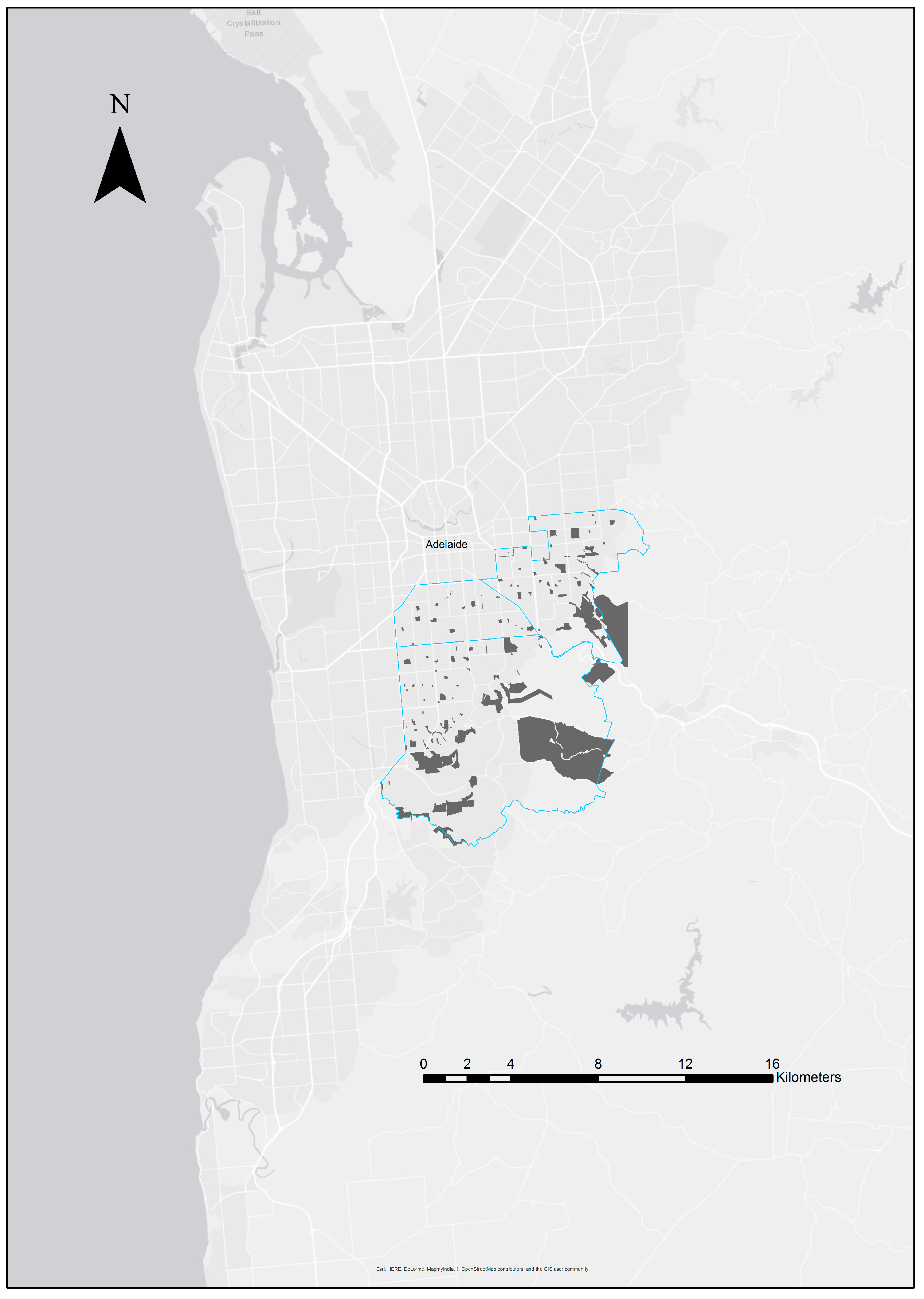
Appendix C
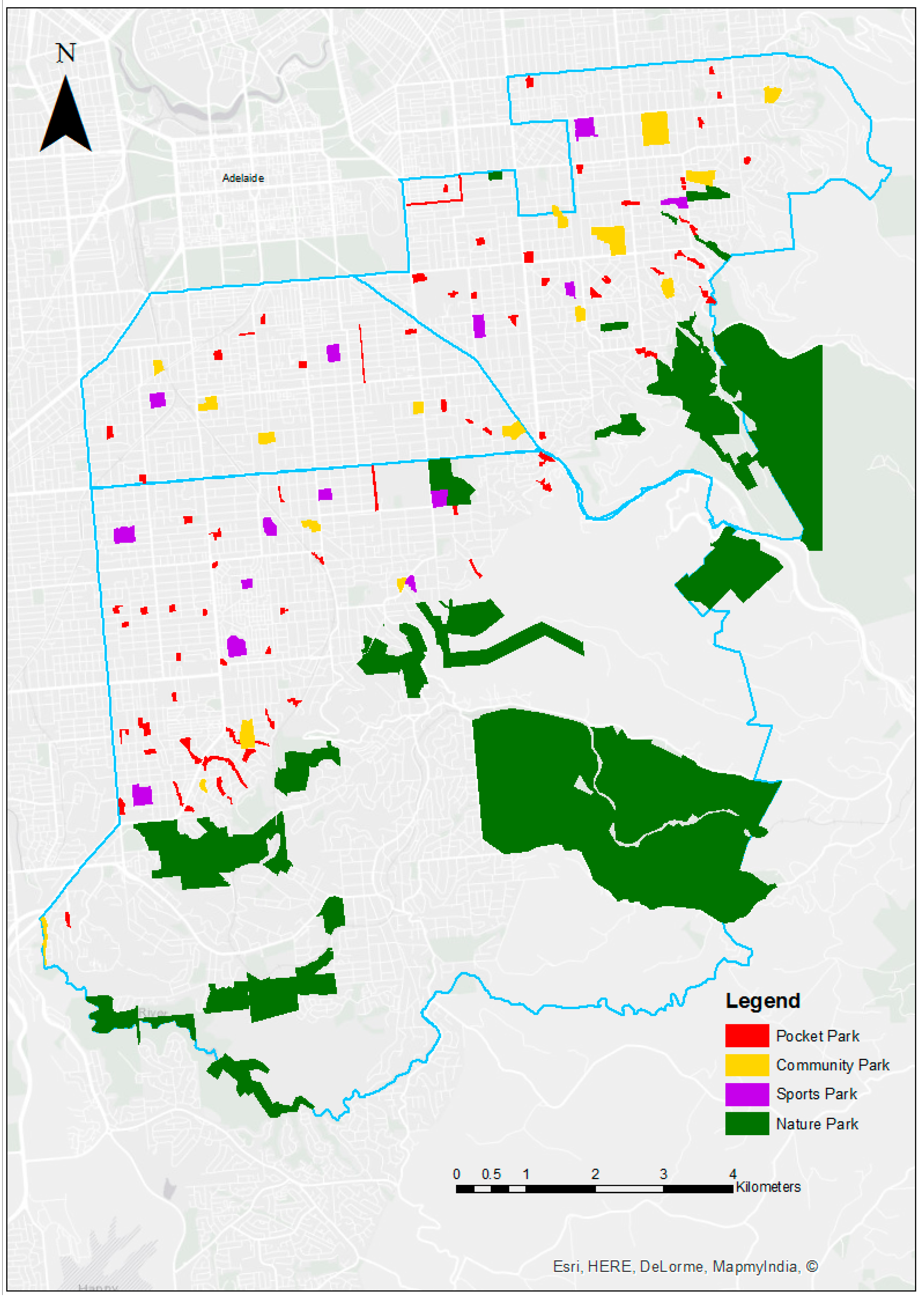
Appendix D. Example of Survey Questions Included in the Study
| Daily | Weekly | Fortnightly | Monthly | Every few months | Yearly | Rarely |
| 1 Very low quality | 2 | 3 | 4 | 5 | 6 | 7 | 8 | 9 | 10 Exceptional quality |
| 1 Very low level of understanding | 2 | 3 | 4 | 5 | 6 | 7 | 8 | 9 | 10 Very high level of understanding |
| 1 Very low level of physical benefit | 2 | 3 | 4 | 5 | 6 | 7 Very high level of physical benefit |
| Enjoy scenery | Mentally unwind, escape everyday pressures | Escape crowds, enjoy solitude | Spend time with friends/family | Improve or maintain fitness | Physically rest/relax | Learn about nature | Other |
| 1 Very low level of diversity | 2 | 3 | 4 | 5 | 6 | 7 Very high level of diversity |
| 1 Very unattractive | 2 | 3 | 4 Neither attractive nor unattractive | 5 | 6 | 7 Very attractive |
| 1 100% artificial and/or urban | 2 | 3 | 4 50% artificial, 50% natural | 5 | 6 | 7 100% natural |
| 1 Very little or no natural shade | 2 | 3 | 4 | 5 | 6 | 7 Lots of natural shade, very shady |
| My stress level: | My mood: | My concentration: | My self-esteem: |
| Excellent | Very good | Good | Fair | Poor |
| Highly important | Fairly important | Neither important nor unimportant | Fairly unimportant | Highly important | I don’t know what biodiversity is |
| Biodiversity | Ecosystem | Remnant Vegetation |
| Island biogeography | Keystone species | Biodiversity hotspot |
| Ecosystem services | Umbrella species | Natural capital |
| Edge Effect | Habitat fragmentation | Endemic species |
| I would not feel confident explaining any of the concept to another person. | ||
| Reduced food security | Increased spread of infectious diseases |
| Substantial ozone depletion | Destruction of potential pharmaceuticals |
| Pollution | Increased frequency of natural disasters |
| I don’t know |
Appendix E
| Park Attribute | Level | Data Range |
|---|---|---|
| Vegetation cover | Very low | 12.2–27.7% |
| Low | 27.71–43.2% | |
| Medium | 43.21–58.7% | |
| High | 58.71–74.2% | |
| Naturalness | Very low | 35–49.5% |
| Low | 49.51–64% | |
| Medium | 64.01–78.5% | |
| High | 78.51–93% | |
| Habitat diversity | Very low | 2–3 habitats |
| Low | 4–5 habitats | |
| Medium | 6–7 habitats | |
| High | 8–10 habitats | |
| Structural heterogeneity | Very low | 7 to 11 elements |
| Low | 12 to 16 elements | |
| Medium | 17 to 21 elements | |
| High | 22 to 26 elements | |
| Bird species richness | Very low | 0–3 species |
| Low | 4–6 species | |
| Medium | 7–9 species | |
| High | 10–13 species |
References
- De Vos, J.M.; Joppa, L.N.; Gittleman, J.L.; Stephens, P.R.; Pimm, S.L. Estimating the normal background rate of species extinction. Conserv. Biol. 2015, 29, 452–462. [Google Scholar] [CrossRef] [PubMed]
- Robertson, D.P.; Hull, R.B. Beyond Biology: Toward a More Public Ecology for Conservation. Conserv. Biol. 2001, 15, 970–979. [Google Scholar] [CrossRef]
- Louv, R. Last Child in the Woods: Saving Our Children from Nature-Deficit Disorder; Algonquin Books: Chapel Hill, NC, USA, 2008. [Google Scholar]
- McDonald, R.I.; Chai, H.Y.; Newell, B.R. Personal experience and the ‘psychological distance’ of climate change: An integrative review. J. Environ. Psychol. 2015, 44, 109–118. [Google Scholar] [CrossRef]
- Li, Y.; Johnson, E.J.; Zaval, L. Local warming: Daily temperature change influences belief in global warming. Psychol. Sci. 2011, 22, 454–459. [Google Scholar] [CrossRef] [PubMed]
- Sandifer, P.A.; Sutton-Grier, A.E.; Ward, B.P. Exploring connections among nature, biodiversity, ecosystem services, and human health and well-being: Opportunities to enhance health and biodiversity conservation. Ecosyst. Serv. 2015, 12, 1–15. [Google Scholar] [CrossRef]
- Keniger, L.E.; Gaston, K.J.; Irvine, K.N.; Fuller, R.A. What are the benefits of interacting with nature? Int. J. Environ. Res. Public Health 2013, 10, 913–935. [Google Scholar] [CrossRef]
- Capaldi, C.A.; Passmore, H.-A.; Nisbet, E.K.; Zelenski, J.M.; Dopko, R.L. Flourishing in nature: A review of the benefits of connecting with nature and its application as a wellbeing intervention. Int. J. Wellbeing 2015, 5. [Google Scholar] [CrossRef]
- Lovell, R.; Wheeler, B.W.; Higgins, S.L.; Irvine, K.N.; Depledge, M.H. A systematic review of the health and well-being benefits of biodiverse environments. J. Toxicol. Environ. Health. B Crit. Rev. 2014, 17, 1–20. [Google Scholar] [CrossRef]
- Fuller, R.A.; Irvine, K.N.; Devine-Wright, P.; Warren, P.H.; Gaston, K.J. Psychological benefits of greenspace increase with biodiversity. Biol. Lett. 2007, 3, 390–394. [Google Scholar] [CrossRef]
- Dallimer, M.; Irvine, K.N.; Skinner, A.M.J.; Davies, Z.G.; Rouquette, J.R.; Maltby, L.L.; Warren, P.H.; Armsworth, P.R.; Gaston, K.J. Biodiversity and the Feel-Good Factor: Understanding Associations between Self-Reported Human Well-being and Species Richness. Bioscience 2012, 62, 47–55. [Google Scholar] [CrossRef]
- Lindemann-Matthies, P.; Bose, E. How Many Species Are There? Public Understanding and Awareness of Biodiversity in Switzerland. Hum. Ecol. 2008, 36, 731–742. [Google Scholar] [CrossRef]
- Shwartz, A.; Turbé, A.; Simon, L.; Julliard, R. Enhancing urban biodiversity and its influence on city-dwellers: An experiment. Biol. Conserv. 2014, 171, 82–90. [Google Scholar] [CrossRef]
- Carrus, G.; Scopelliti, M.; Lafortezza, R.; Colangelo, G.; Ferrini, F.; Salbitano, F.; Agrimi, M.; Portoghesi, L.; Semenzato, P.; Sanesi, G. Go greener, feel better? The positive effects of biodiversity on the well-being of individuals visiting urban and peri-urban green areas. Landsc. Urban Plan. 2015, 134, 221–228. [Google Scholar] [CrossRef]
- Van den Berg, A.E.; Jorgensen, A.; Wilson, E.R. Evaluating restoration in urban green spaces: Does setting type make a difference? Landsc. Urban Plan. 2014, 127, 173–181. [Google Scholar] [CrossRef]
- Brown, G.; Schebella, M.F.; Weber, D. Using participatory GIS to measure physical activity and urban park benefits. Landsc. Urban Plan. 2014, 121, 34–44. [Google Scholar] [CrossRef]
- Schebella, M.F.; Weber, D.; Lindsey, K.; Daniels, C.B. For the Love of Nature: Exploring the Importance of Species Diversity and Micro-Variables Associated with Favorite Outdoor Places. Front. Psychol. 2017, 8, 2094. [Google Scholar] [CrossRef]
- Nordh, H.; Hartig, T.; Hagerhall, C.M.; Fry, G. Components of small urban parks that predict the possibility for restoration. Urban For. Urban Green. 2009, 8, 225–235. [Google Scholar] [CrossRef]
- Australian Bureau of Statistics. Data by Region, 2011–2016; Australian Bureau of Statistics: Canberra, Australia, 2017.
- Mertes, J.D.; Hall, J.R. Park, Recreation, Open Space and Greenway Guidelines; National Recreation and Park Association: Ashburn, VA, USA, 1996. [Google Scholar]
- Machado, A. An index of naturalness. J. Nat. Conserv. 2004, 12, 95–110. [Google Scholar] [CrossRef]
- DeMaris, A. Regression with Social Data: Modeling Continuous and Limited Response Variables; Willey: Hoboken, NJ, USA, 2005. [Google Scholar]
- Driver, B.L.; Brown, P.J. The Opportunity Spectrum Concept and Behavioral Information in Outdoor Recreation Resource Supply Inventories: A Rationale; USDA Forest Service General Technical Report RM-55; Rocky Mountain Forest and Range Experiment Station: Fort Collins, CO, USA, 1978.
- Manfredo, M.J.; Driver, B.L.; Tarrant, M.A. Measuring Leisure Motivation: A Meta-Analysis of the Recreation Experience Preference Scales. J. Leisure Res. 1996, 28, 188–213. [Google Scholar] [CrossRef]
- Weber, D.; Anderson, D. Contact with nature: Recreation experience preferences in Australian parks. Ann. Leisure Res. 2010, 13, 46–69. [Google Scholar] [CrossRef]
- Moore, R.L.; Driver, B.L. Introduction to Outdoor Education: Providing and Managing Natural Resource Based Opportunities; Venture Publishing, Inc.: State College, PA, USA, 2005. [Google Scholar]
- Australian Bureau of Statistics. 2016 Census QuickStats: Burnside; Australian Bureau of Statistics: Canberra, Australia, 2017.
- Australian Bureau of Statistics. 2016 Census QuickStats: Mitcham; Australian Bureau of Statistics: Canberra, Australia, 2017.
- Australian Bureau of Statistics. 2016 Census QuickStats: Unley; Australian Bureau of Statistics: Canberra, Australia, 2017.
- Bowerman, B.L.; O’Connell, R.T. Linear Statistical Models: An Applied Approach; Duxbury Press: Singapore, 1990. [Google Scholar]
- Hartig, T.; Korpela, K.; Evans, G.W.; Garling, T. A measure of restorative quality in environments. Scand. Hous. Plan. Res. 1997, 14, 175–194. [Google Scholar] [CrossRef]
- Wall, D.H.; Nielsen, U.N.; Six, J. Soil biodiversity and human health. Nature 2015, 528, 69. [Google Scholar] [CrossRef]
- Kaplan, R.; Kaplan, S. The Experience of Nature: A Psychological Perspective; Cambridge University Press: Cambridge, UK, 1989. [Google Scholar]
- Atkinson, S. Moves to measure wellbeing must support a social model of health. BMJ 2011, 343. [Google Scholar] [CrossRef]
- Morgan, P. Towards a developmental theory of place attachment. J. Environ. Psychol. 2010, 30, 11–22. [Google Scholar] [CrossRef]
- Fuller, S.; Atkinson, S. Wellbeing and Place; Taylor & Francis: Didcot, UK, 2016. [Google Scholar]
- Korpela, K.M.; Ylen, M.P. Effectiveness of Favorite-Place Prescriptions A Field Experiment. Am. J. Prev. Med. 2009, 36, 435–438. [Google Scholar] [CrossRef]
- Collado, S.; Staats, H.; Sorrel, M.A. A relational model of perceived restorativeness: Intertwined effects of obligations, familiarity, security and parental supervision. J. Environ. Psychol. 2016, 48, 24–32. [Google Scholar] [CrossRef]
- Pitman, S.D.; Daniels, C.B.; Sutton, P.C. Ecological literacy and socio-demographics: Who are the most eco-literate in our community, and why? Int. J. Sustain. Dev. World Ecol. 2018, 25, 9–22. [Google Scholar] [CrossRef]
- Pellico, L.H.; Friedlaender, L.; Fennie, K.P. Looking is not seeing: Using art to improve observational skills. J. Nurs. Educ. 2009, 48, 648–653. [Google Scholar] [CrossRef]
- Braverman, I.M. To see or not to see: How visual training can improve observational skills. Clin. Dermatol. 2011, 29, 343–346. [Google Scholar] [CrossRef]
- Richardson, M.; Sheffield, D. Three good things in nature: Noticing nearby nature brings sustained increases in connection with nature/Tres cosas buenas de la naturaleza: Prestar atención a la naturaleza cercana produce incrementos prolongados en conexión con la naturaleza. Psyecology 2017, 8, 1–32. [Google Scholar] [CrossRef]
- Barton, J.; Hine, R.; Pretty, J. The health benefits of walking in greenspaces of high natural and heritage value. J. Integr. Environ. Sci. 2009, 6, 261–278. [Google Scholar] [CrossRef]
- Martens, D.; Gutscher, H.; Bauer, N. Walking in “wild” and “tended” urban forests: The impact on psychological well-being. J. Environ. Psychol. 2011, 31, 36–44. [Google Scholar] [CrossRef]
- Jorgensen, A.; Wilson, E.; Van den Berg, A.E. Evaluating stress relief in urban green and open spaces: Does perceived naturaless make a difference? In Proceedings of the Trees and Forests in British Society Conference, Edinburgh, UK, 13–15 April 2010. [Google Scholar]
- Johansson, M.; Gyllin, M.; Witzell, J.; Küller, M. Does biological quality matter? Direct and reflected appraisal of biodiversity in temperate deciduous broad-leaf forest. Urban For. Urban Green. 2014, 13, 28–37. [Google Scholar] [CrossRef]
- Chang, K.; Sullivan, W.; Lin, Y.-H.; Su, W.; Chang, C.-Y. The Effect of Biodiversity on Green Space Users’ Wellbeing—An Empirical Investigation Using Physiological Evidence. Sustainability 2016, 8, 1049. [Google Scholar] [CrossRef]
- Marselle, M.R.; Irvine, K.N.; Lorenzo-Arribas, A.; Warber, S.L. Moving beyond Green: Exploring the Relationship of Environment Type and Indicators of Perceived Environmental Quality on Emotional Well-Being following Group Walks. Int. J. Environ. Res. Public Health 2015, 12, 106–130. [Google Scholar] [CrossRef] [PubMed]
- Cracknell, D.; White, M.P.; Pahl, S.; Nichols, W.J.; Depledge, M.H. Marine Biota and Psychological Well-Being: A Preliminary Examination of Dose-Response Effects in an Aquarium Setting. Environ. Behav. 2016, 48, 1242–1269. [Google Scholar] [CrossRef] [PubMed]
- Hoyle, H.; Hitchmough, J.; Jorgensen, A. All about the ‘wow factor’? The relationships between aesthetics, restorative effect and perceived biodiversity in designed urban planting. Landsc. Urban Plan. 2017, 164, 109–123. [Google Scholar] [CrossRef]
- Sikorska, D.; Sikorski, P.; Hopkins, R. High Biodiversity of Green Infrastructure Does Not Contribute to Recreational Ecosystem Services. Sustainability 2017, 9, 334. [Google Scholar] [CrossRef]
- Wood, E.; Harsant, A.; Dallimer, M.; Cronin de Chavez, A.; McEachan, R.R.C.; Hassall, C. Not All Green Space Is Created Equal: Biodiversity Predicts Psychological Restorative Benefits from Urban Green Space. Front. Psychol. 2018, 9. [Google Scholar] [CrossRef]
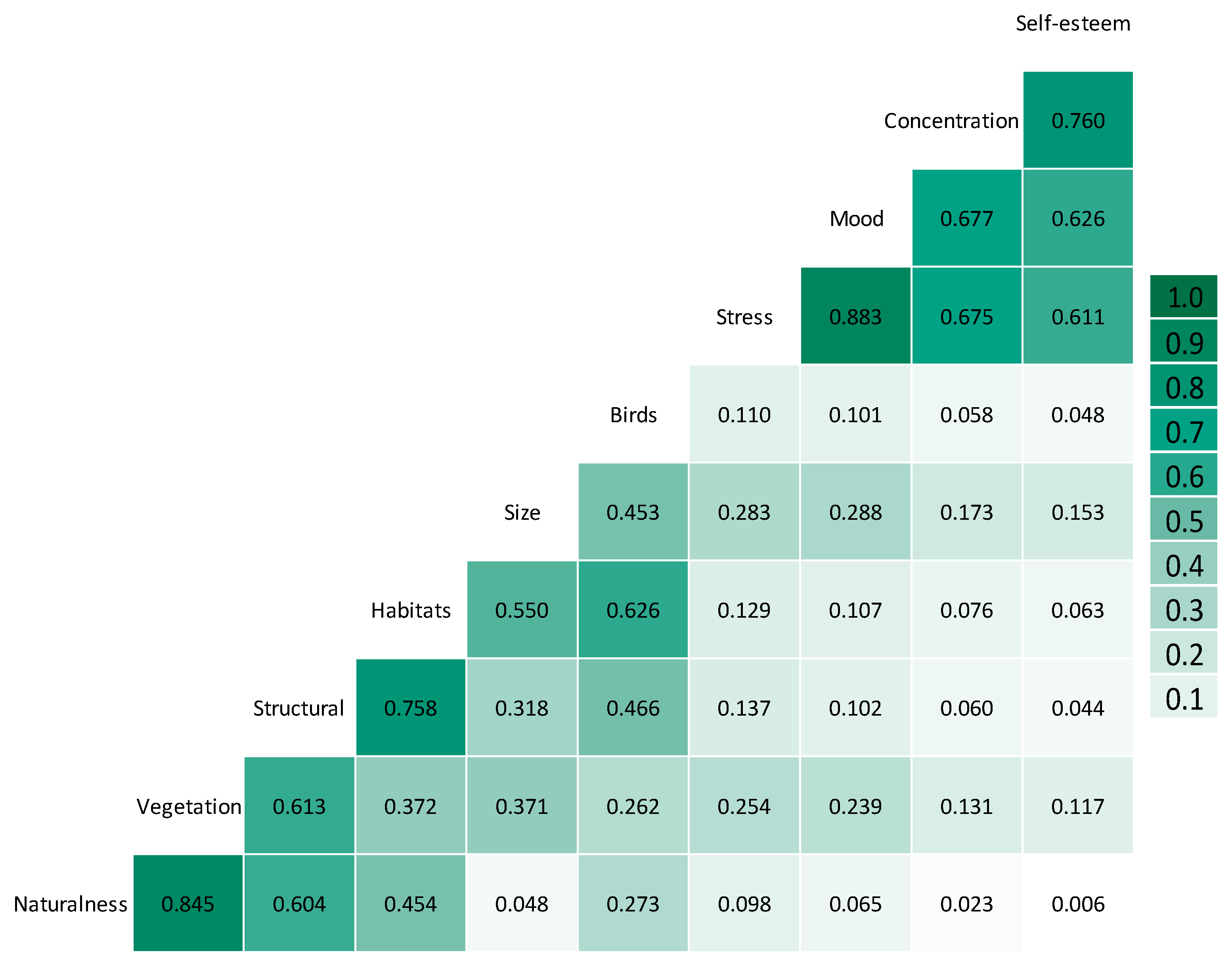
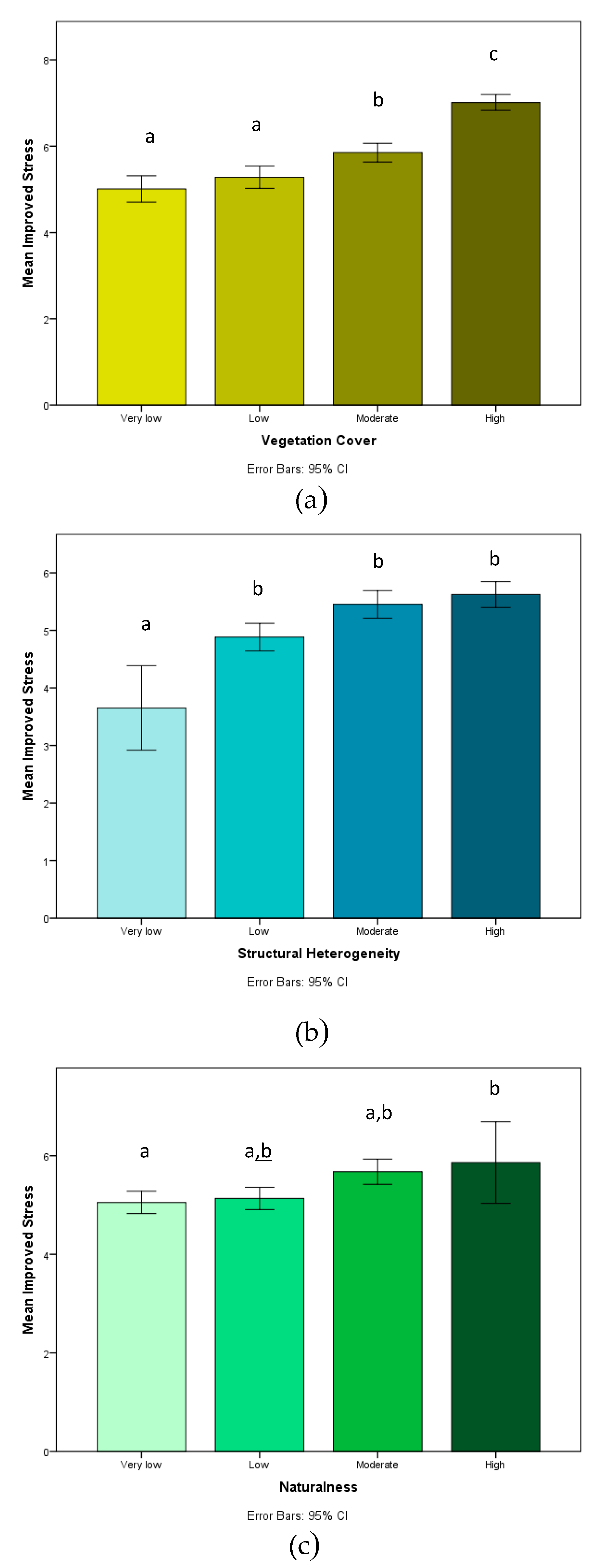
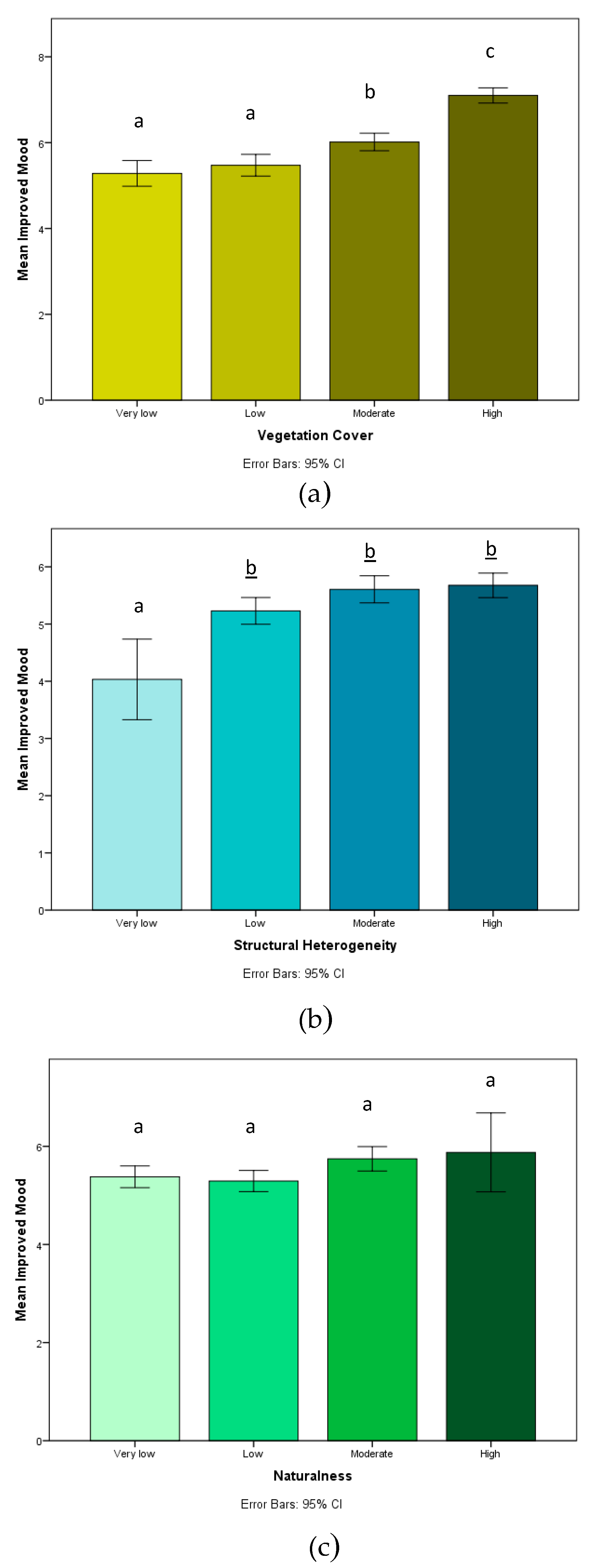
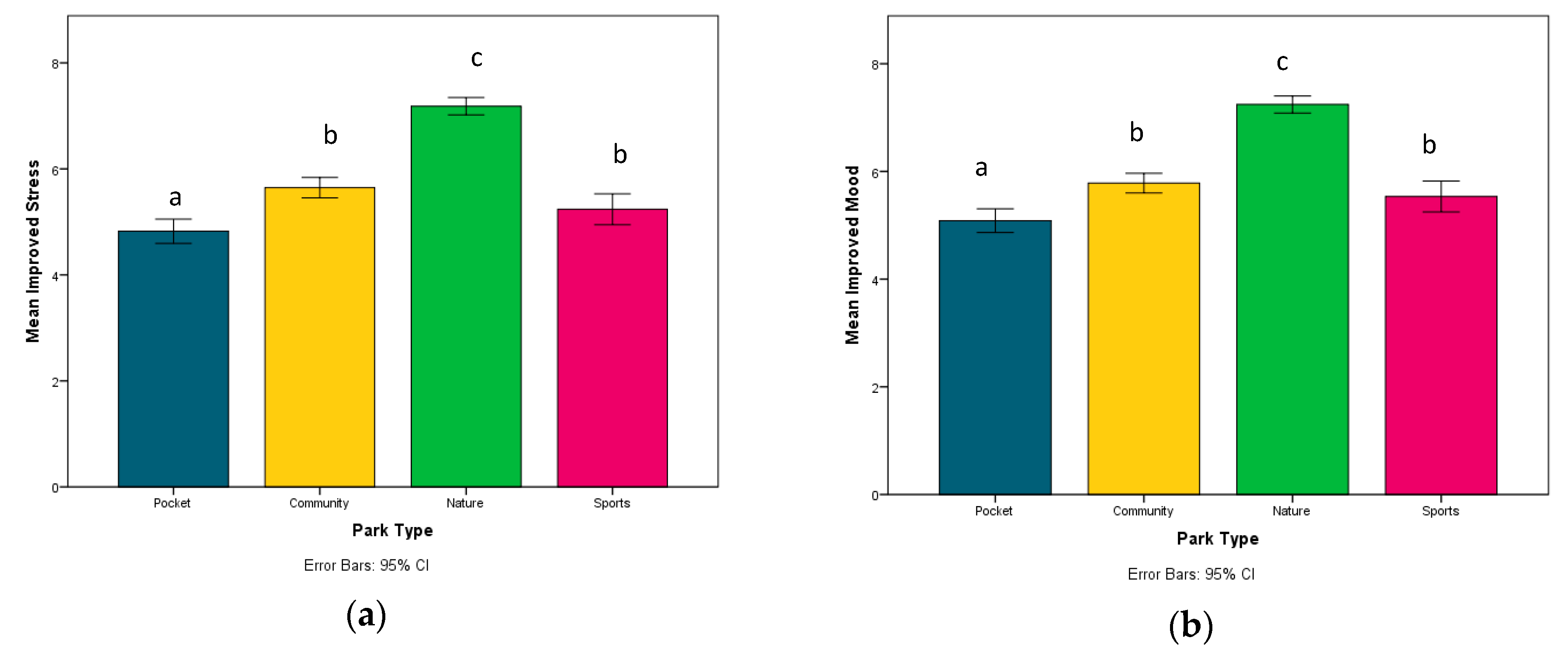
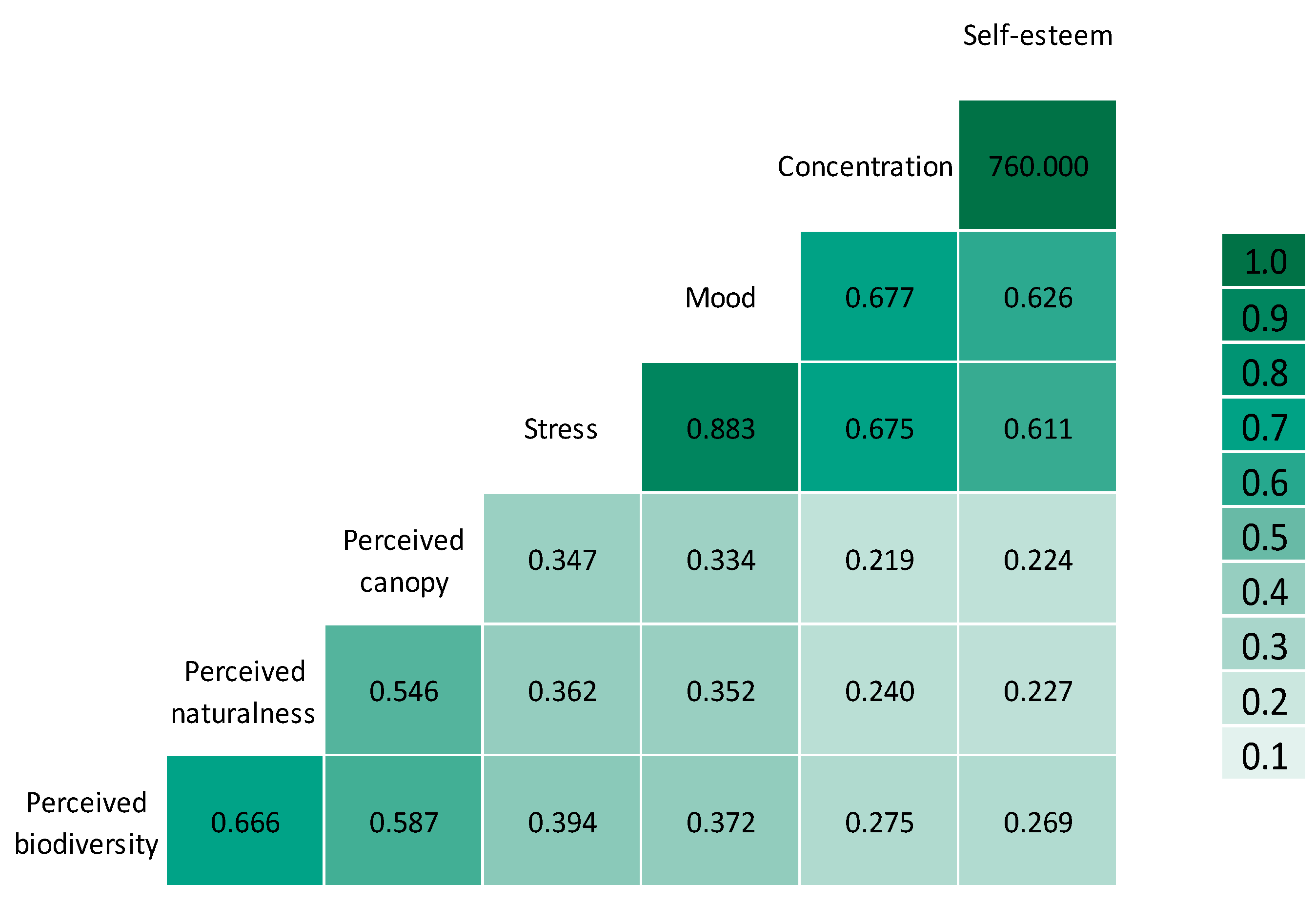
| Classification | Proportion of Parks in Study | Description | NRPA Classification | NRPA Size Criteria | Modification Rationale |
|---|---|---|---|---|---|
| Pocket park | 59.70% | 0.4–1.99 ha | Mini-park | Between 2500 sq. ft. and 1 acre. | Size converted to metric and minimum size increased to 0.4 ha (4300 sq. ft.) as parks were assessed on-site. Name change reflects terminology used in local community |
| Community Park | 12.69% | 2–20 ha | Neighbourhood park Community park | 5–10 acres 30–50 acres | Community and neighbourhood parks were combined, as they are largely delineated by size rather than intended use, and there only two community parks greater than 30 acres within the study area |
| Sports park | 10.45% | Size variable, dominated by features intended for sports use, e.g., oval, court | Sports complex Special use | At least 25 acres Variable | Sports complex and special use combined to accommodate smaller sports-oriented parks. Name change clarifies that these areas are parks |
| Nature park | 17.16% | Size variable, natural resource sites, conservation areas, botanic gardens and arboreta | Natural resource areas | Variable | Name change clarifies that these areas are publicly accessible parks |
| Greenways | Variable | Excluded. One potential greenway in the study area comprised three small parks, each separated by a road, but in reality, appearing as a continuation of a botanic park, and thus classified as nature parks | |||
| School park | Variable | Excluded. Often not publicly accessible | |||
| Large urban park | At least 50 acres | Excluded. Not present in study area | |||
| Private park/recreation facility | Variable | Excluded. Not present in study area |
| Benefit | Domain |
|---|---|
| Enjoy scenery | Environmental |
| Learn about nature Mentally unwind, escape pressures | Environmental Psychological |
| Escape crowds, enjoy solitude | Psychological |
| Spend time with friends/family | Social |
| Improve or maintain fitness | Physical |
| Physically rest/relax | Physical |
| Self-Reported Benefit | R Square | Standard Error | p-value |
|---|---|---|---|
| Improved stress level | 0.029 | 2.866 | <0.01 † |
| Improved mood | 0.019 | 2.781 | <0.01 † |
| Improved concentration | 0.007 | 3.052 | <0.05 † |
| Improved self-esteem | 0.004 | 3.181 | 0.22 |
| Naturalness | Environmental | Psychological | Physical | Social | |
|---|---|---|---|---|---|
| Very low | 25.5% | 31.8% | 37.1% | 37.9% | 34.9% |
| −2.0 | −1.1 | 0.9 | 1.1 | ||
| Low | 26.1% | 34.8% | 32.7% | 42.5% | 35.4% |
| −1.9 | −0.2 | −1.1 | 2.6 | ||
| Moderate | 40.5% | 28.2% | 27.1% | 19.4% | 26.5% |
| 3.4 | 0.7 | 0.3 | −3.0 | ||
| High | 7.8% | 5.2% | 3.1% | 0.2% | 3.3% |
| 3.1 | 2.2 | −0.3 | −3.6 | ||
| Total | 153 | 443 | 617 | 464 | 1677 |
| 9.1% | 26.4% | 36.8% | 27.7% | 100.0% |
| Vegetation Cover | Environmental | Psychological | Physical | Social | |
|---|---|---|---|---|---|
| Very low | 4.1% | 18.5% | 29.7% | 25.2% | 23.0% |
| −4.4 | −1.7 | 3.0 | 0.9 | ||
| Low | 25.4% | 25.9% | 22.5% | 32.5% | 26.5% |
| −0.2 | −0.2 | −1.7 | 2.2 | ||
| Moderate | 27.0% | 29.8% | 29.9% | 35.6% | 31.2% |
| −0.8 | −0.5 | −0.5 | 1.5 | ||
| High | 43.4% | 25.9% | 18.0% | 6.7% | 19.3% |
| 6.1 | 2.7 | −0.7 | −5.4 | ||
| Total | 122 | 336 | 462 | 357 | 1277 |
| 9.6% | 26.3% | 36.2% | 28.0% | 100.0% |
| Park Type | Environmental | Psychological | Physical | Social | |
|---|---|---|---|---|---|
| 37.1% | 37.3% | 37.3% | 39.4% | 37.9% | |
| −0.2 | −0.2 | −0.2 | 0.5 | ||
| Community | 29.1% | 28.2% | 27.4% | 38.1% | 30.7% |
| −0.3 | −0.9 | −1.5 | 2.8 | ||
| Nature | 27.8% | 17.1% | 8.4% | 1.8% | 10.7% |
| 6.4 | 4.0 | −1.7 | −5.7 | ||
| Sports | 6.0% | 17.4% | 26.9% | 20.7% | 20.7% |
| −4.0 | −1.5 | 3.3 | 0.0 | ||
| Total | 151 | 426 | 592 | 444 | 1613 |
| 9.4% | 26.4% | 36.7% | 27.5% | 100.0% |
| Self-Reported Benefit | R Square | Standard Error | p-value |
|---|---|---|---|
| Improved stress level | 0.168 | 2.712 | <0.01 |
| Improved mood | 0.154 | 2.68 | <0.01 |
| Improved concentration | 0.083 | 3.054 | <0.01 |
| Improved self-esteem | 0.085 | 3.137 | <0.01 |
| Additional Variables Included | R Square | Standard Error | p-value |
|---|---|---|---|
| Demographic | 0.070 | 2.825 | <0.01 |
| Health | 0.086 | 2.818 | <0.01 |
| Location | 0.068 | 2.810 | <0.01 |
| Environmental knowledge | 0.065 | 2.768 | <0.01 |
| Nature values | 0.110 | 2.727 | <0.01 |
| Use characteristics | 0.162 | 2.675 | <0.01 |
© 2019 by the authors. Licensee MDPI, Basel, Switzerland. This article is an open access article distributed under the terms and conditions of the Creative Commons Attribution (CC BY) license (http://creativecommons.org/licenses/by/4.0/).
Share and Cite
Schebella, M.F.; Weber, D.; Schultz, L.; Weinstein, P. The Wellbeing Benefits Associated with Perceived and Measured Biodiversity in Australian Urban Green Spaces. Sustainability 2019, 11, 802. https://doi.org/10.3390/su11030802
Schebella MF, Weber D, Schultz L, Weinstein P. The Wellbeing Benefits Associated with Perceived and Measured Biodiversity in Australian Urban Green Spaces. Sustainability. 2019; 11(3):802. https://doi.org/10.3390/su11030802
Chicago/Turabian StyleSchebella, Morgan Faith, Delene Weber, Lisa Schultz, and Philip Weinstein. 2019. "The Wellbeing Benefits Associated with Perceived and Measured Biodiversity in Australian Urban Green Spaces" Sustainability 11, no. 3: 802. https://doi.org/10.3390/su11030802
APA StyleSchebella, M. F., Weber, D., Schultz, L., & Weinstein, P. (2019). The Wellbeing Benefits Associated with Perceived and Measured Biodiversity in Australian Urban Green Spaces. Sustainability, 11(3), 802. https://doi.org/10.3390/su11030802





